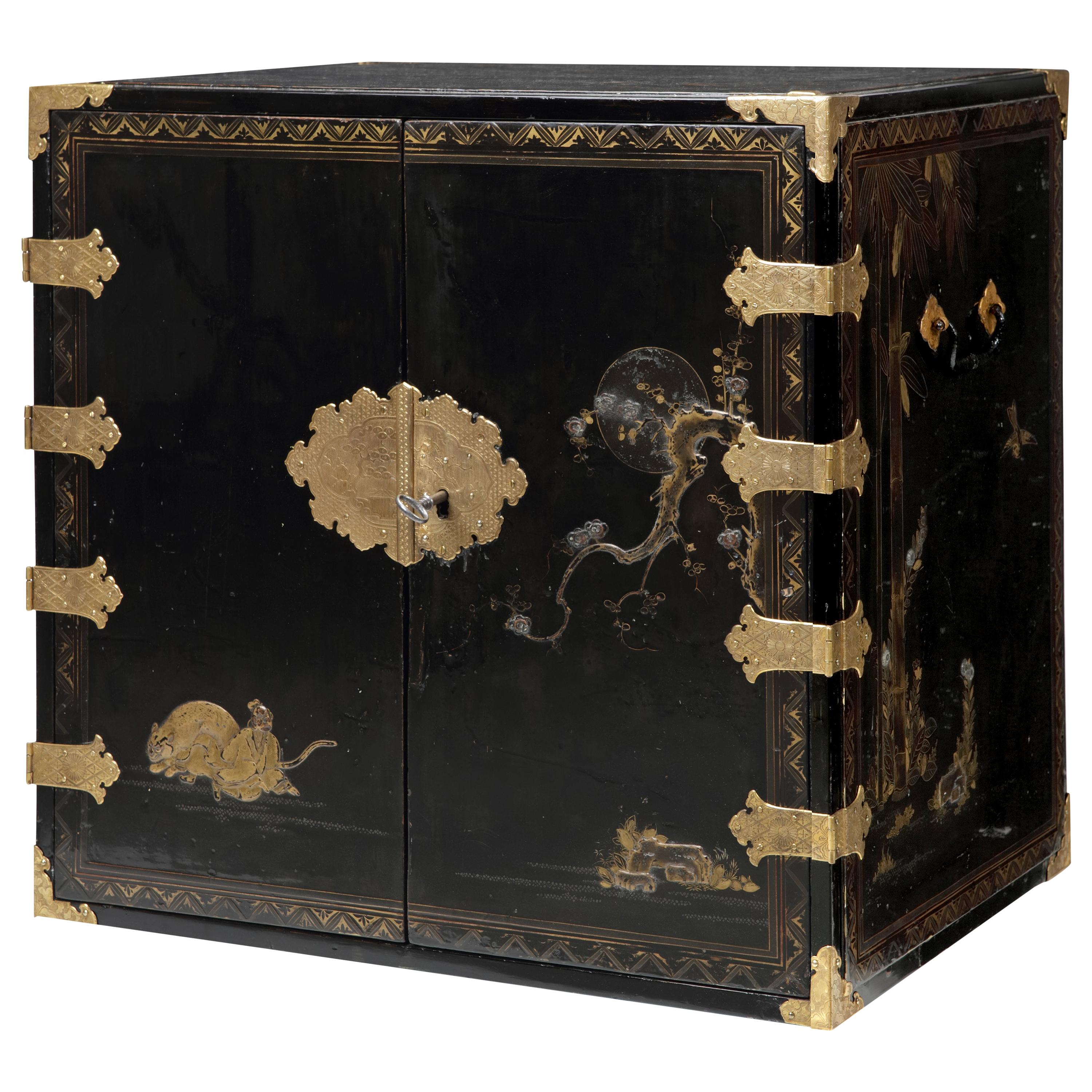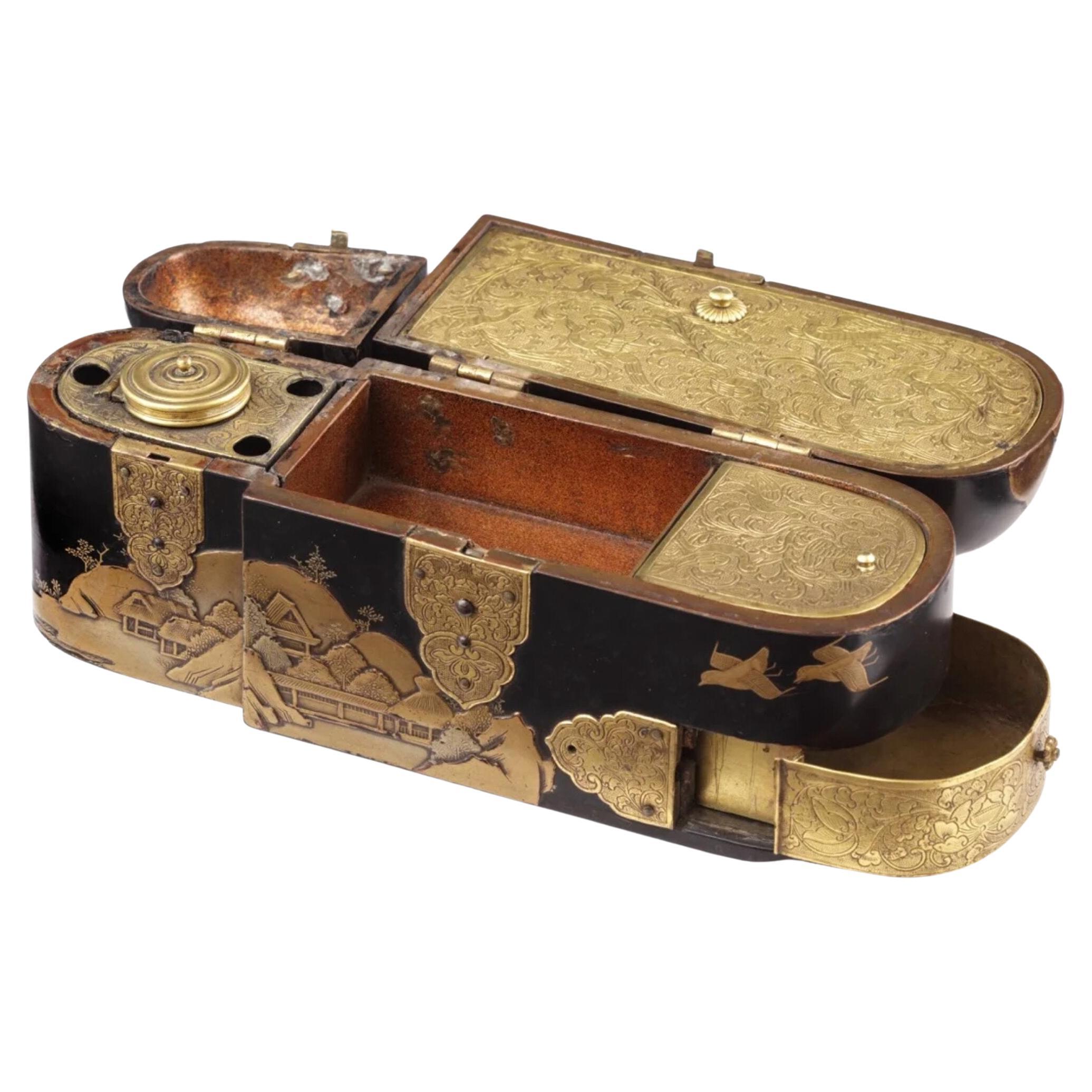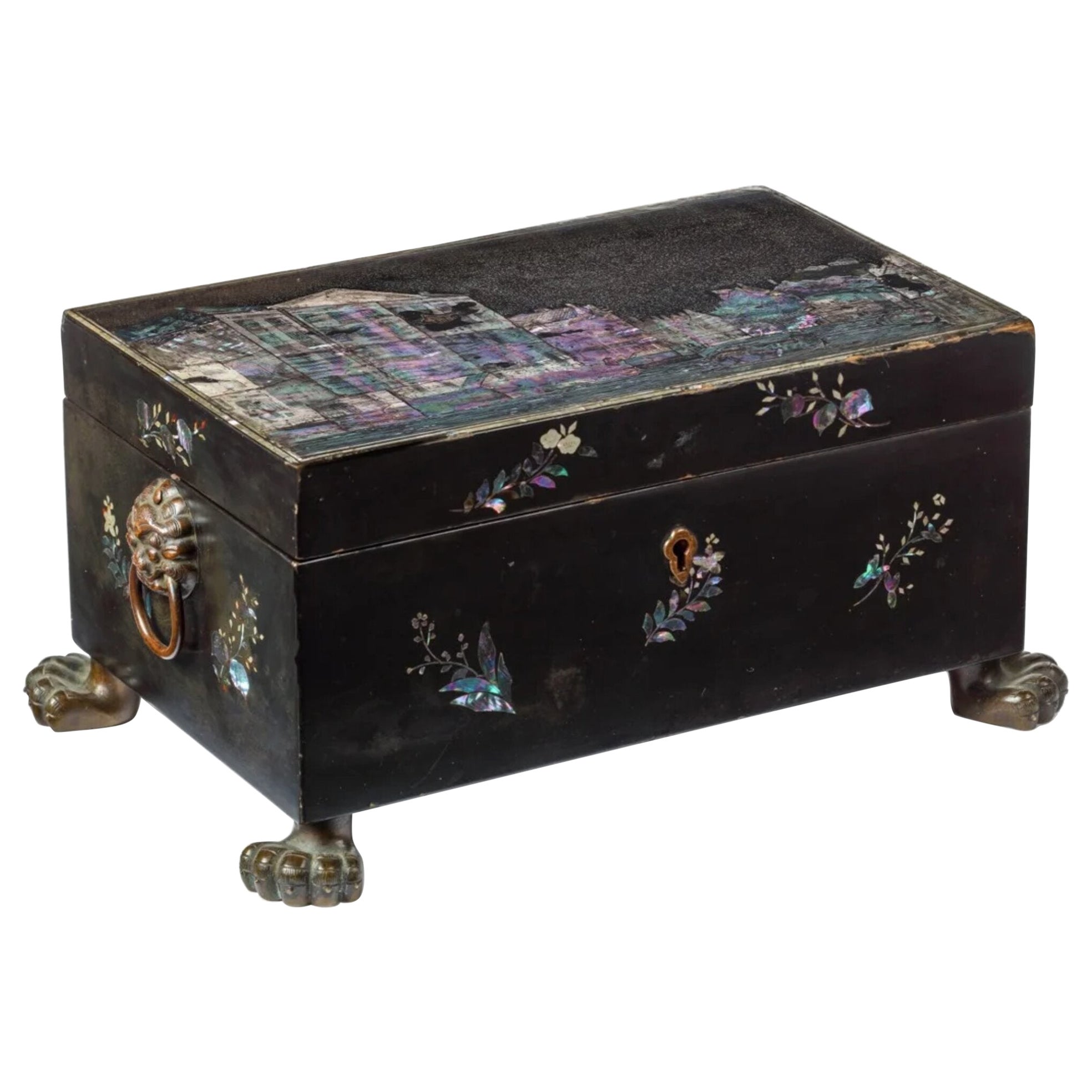Items Similar to 17th Century Japanese Export Lacquer Cabinet with Depiction the Dutch Tradepost
Video Loading
Want more images or videos?
Request additional images or videos from the seller
1 of 8
17th Century Japanese Export Lacquer Cabinet with Depiction the Dutch Tradepost
About the Item
A highly important Japanese export lacquer cabinet with depiction of the Dutch East India Company tradepost Deshima and the annual Dutch delegation on its way to the Shogun in Edo
Edo period, circa 1660-1680
H. 88 x W. 100.5 x D. 54 cm
This cabinet includes a later European japanned stand, but also a modern powder-coated steel frame.
The latter can be designed and added to your specific needs.
The sides and front of the rectangular two-door cabinet are embellished in gold and silver hiramaki-e and takamaki-e on a black roiro lacquer ground with a continuous design. The two doors depict a long procession of numerous figures travelling on foot and horseback along buildings and a pagoda into a mountainous landscape. This is the annual court journey, Hofreis, of the Dutch from Nagasaki to the Shogun’s court in Edo. Three horseback riders are dressed as Dutch merchants and a fourth figure, probably het Opperhoofd, is seen inside a palanquin, norimon. Just about to cross the bridge, two men are carrying a cabinet like the present one.
Many Japanese figures on either side of the procession are engaged in various activities; some play musical instruments on board of small boats, others are fishing; figures inside buildings are depicted playing go, and farmers are tending to their rice paddocks. The upper part of the right door shows a large mansion, probably the local daimyo’s castle, with men kneeling before a man in the central courtyard.
The court journey fits in with the foreign policy of the shogunate which accorded a role to the VOC alongside China, Korea, and the Ryukyu Islands who also had to pay tribute. However, the VOC employees were traders, having low status in Japan’s social hierarchy, and they were received with less deference than were the state embassies from Korea and the Ryukyu Islands. Nevertheless, the contacts with the Dutch were a welcome source of information to the Shogun about Europe and European science and technology.
The left side of the cabinet depicts, in mirror image, a rare view of the artificial fan-shaped Deshima Island, the trading post for the Dutch in Japan. The island, where the Dutch flag flies, is surrounded by small Japanese boats and an anchored three-masted fluyt (cargo ship), flying Dutch flags, with on the stern the VOC monogram. On the bottom right a busy street of Nagasaki is shown, bordered by shops and leading up to the stone bridge. On the island the trees are beautifully painted, two cows can be seen, and the flagpole, all in very fine detail. Dutchmen and enslaved Malay are visible outside the buildings and two Japanese figures, probably guards, sit in a small hut in the centre.
A maximum of fifteen to twenty Dutchmen lived on the island at any time and soldiers or women were not allowed. Restrictions on Deshima were tight, and the merchants were only allowed to leave the island by special permission. The Opperhoofd had to be replaced every year, and each new Opperhoofd had to make a court journey to pay tribute, present gifts, and to obtain permission to Margaret Barclay eep on trading. In the distance, many birds fly above the hills and a four-story pagoda can be seen. The right side of the cabinet is painted with other horse riders and their retinue journeying through mountains.
The pair of doors to the front open to reveal ten rectangular drawers. The drawers are decorated with scenes of birds in flight and landscapes with trees and plants. The reverse of the left door with two thatched buildings, one with a ladder, underneath a camelia tree with large blooms; the right door with a three-story pagoda nestled among trees and both doors with a flying phoenix, ho-oo bird. The cabinet, with elaborately engraved gilt copper mounts, hinges, lock plates and brass handles, is raised on an 18th-century English japanned wood stand.
A pair of large cabinets (H. 109 x W. 117 x D. 73 cm) with eighteen drawers behind the front doors, instead of the ten in the present cabinet, is in the Dutch Royal Collection presently in palace Huis ten Bosch in The Hague. Among the largest known, these two beautiful cabinets can be dated around 1660-1680. The subject of the decorations on these cabinets is the same as on the present cabinet; the procession of the Dutch, with the Opperhoofd in a sedan chair, norimon, carried by four bearers, the scribe, or head secretary, and the trading post physician, accompanied by a large entourage of Japanese officials and servants, leaving Deshima Island on the court journey to the Shogun in Edo. The Royal pair of cabinets depicts the procession of the Dutch in mirror image; one shows the departure of the procession from Deshima Island going from left to right, and the other the same procession going from right to left.
These two cabinets were first inventoried in 1684 when they belonged to Princess Albertina Agnes (1634-1696), daughter of Stadtholder Frederik Hendrik (1584-1647) and Amalia van Solms (1602-1675). They were part of the furnishings of Albertina’s castle Oranienstein in Dietz, Germany. This pair, which must have been very expensive, was probably a gift by the VOC to her mother Amalia - although no sources prove this. However, it would be unlikely for the VOC to present the sixth daughter of Amalia, who lived in Germany with such an exuberant gift. It is known that the VOC gifted Amalia about 20 years earlier a bed of state fence in fine lacquer, of which in 2021 we discovered one intact baluster. Albertina Agnes in 1652 married her second cousin Willem Frederik van Nassau-Dietz, Stadtholder of Friesland, Groningen and Drenthe, and the ancestor of the present Dutch Royal family.
A fourth cabinet depicting Deshima and the procession of the Dutch on their court journey to Edo is in the Muse´e des Beaux-Arts, Dijon (inv. 3550-6) and was exhibited in the exhibition ‘Asia in Amsterdam, the culture of luxury in the Golden Age’ in the Rijksmuseum, 17 October
2015 – 17 January 2016, and in the Peabody Essex Museum, 27 February – 5 June 2016. This cabinet is not covered in black lacquer but in transparent lacquer with gold and silver hiramaki-e and takamaki-e lacquer, gold foil and copper mounts, and is dated between 1665 and 1685. The landscape on the doors is dominated by Mount Fuji in silver maki-e, which in its original non-oxidized state would clearly have shown the snow-clad mountain top. On the right side of the cabinet is the procession of the Dutch on their annual court journey to pay their respect to the Shogun in Edo. The left side of the cabinet shows the Dutch trading post on Deshima in the port of Nagasaki.
The present cabinet and the one in the Muse´e des Beaux- Arts in Dijon must have been ordered by or for a high-ranking VOC official at about the same time the two cabinets in the Royal Collection were commissioned, most likely by the Amsterdam VOC Chamber.
The present cabinet is slightly smaller than the Royal pair of cabinets and the Muse´e des Beaux-Arts one but arguably is finer in detail.
Provenance:
English private collection formerly at Cliff Avenue, Cromer, Norfolk, since the 1950s and thence by descent.
By repute purchased by the family from Margaret Jane Barclay (1861- 1958) of Herne Close, Cromer, together with the entire contents of her house. An album with watercolours by Margaret Barclay was found in the cabinet.
Margaret’s ancestor James Barclay (1708-1766), established Barclay’s banking dynasty. The cabinet was likely purchased by Margaret’s father, Joseph Gurney Barclay (1816-1898), who built Herne Close as a holiday house and furnished it. Joseph was one of the wealthiest members of the Barclay family, leaving many properties and a fortune to his children after his death.
- Dimensions:Height: 34.65 in (88 cm)Width: 39.57 in (100.5 cm)Depth: 21.26 in (54 cm)
- Style:Edo (Of the Period)
- Materials and Techniques:
- Place of Origin:
- Period:
- Date of Manufacture:circa 1660-1680
- Condition:Wear consistent with age and use. Minor losses. The cabinet has been cleaned, and a new upper layer of urushi lacquer has been applied to deepen the black.
- Seller Location:Amsterdam, NL
- Reference Number:1stDibs: LU5458233869942
About the Seller
5.0
Vetted Seller
These experienced sellers undergo a comprehensive evaluation by our team of in-house experts.
Established in 1985
1stDibs seller since 2020
19 sales on 1stDibs
Typical response time: 3 hours
- ShippingRetrieving quote...Ships From: Amsterdam, Netherlands
- Return PolicyA return for this item may be initiated within 7 days of delivery.
More From This SellerView All
- Rare Charming 17th Century Japanese Lacquer Cabinet with Gilt-Bronze MountsLocated in Amsterdam, NLA fine Japanese pictoral style lacquer cabinet with gilt-metal mounts Kyoto, Edo period, 1670-1690 Decorated in Japanese relief lacquer work, black lacquer ground decorated...Category
Antique Late 17th Century Japanese Furniture
MaterialsBronze
- 18th Century Chinese Export Lacquer Chinoiserie Bureau Desk for the Dutch MarketLocated in Amsterdam, NLAn extremely rare, possibly unique, Chinese export lacquer bureau for the Dutch market Canton, circa 1737 H. 118 x W. 102.5 x D. 63 cm Provenance: - Private collection, The Netherlands - J.K. Driessen Antiques, Arnhem (Art Fair Breda, 1989) - Noble collection, Belgium Literature: - C.J.A. Jörg, ’De handel van de V.O.C. in Oosters lakwerk in de 18de eeuw’ in: Nederlands Kunsthistorisch Jaarboek , Jr. 31 (1980), pp. 355-363 (ill.) - Annigje Hofstede, Nederlandse meubelen van Barok tot Biedermeier, 1700-1830, Waanders, Zwolle 2004, pp. 35-37 (ill.) This lacquer bureau is one of the four writing desks purchased in Canton in 1737, and as far as is known, this is the only remaining bureau of its type from the period. As the VOC believed that large pieces of import took up too much valuable space in their trading ships...Category
Antique Mid-18th Century Chinese Chinese Export Lacquer
MaterialsWood, Cypress, Lacquer
- Rare 17th Century Japanese Export Lacquer Medical Instrument BoxLocated in Amsterdam, NLA rare Japanese export lacquer medical instrument box Edo-period, 1650-1700 L. 19 x W. 6 x H. 8.5 cm This unconventionally shaped lacquer b...Category
Antique 17th Century Japanese Edo Lacquer
MaterialsGold
- Japanese Nagasaki Export Lacquer Box with Depiction of the 'Trippenhuis'Located in Amsterdam, NLA Japanese Nagasaki export lacquer box with mother-of-pearl depiction of the Amsterdam ‘Trippenhuis’ Edo-period, circa 1830 H. 12.5 x W. 24 x D. 15 cm ? The house depicted on t...Category
Antique 19th Century Japanese Edo Lacquer
MaterialsMother-of-Pearl, Lacquer
- Extremely Fine and Rare 17th-Century Japanese Export Lacquer and Inlaid CabinetLocated in Amsterdam, NLAn extremely fine and important Japanese lacquer cabinet with gilt-copper mounts for the European market Edo period, late 17th century The pictorial style decorated rectangular...Category
Antique Late 17th Century Japanese Lacquer
MaterialsBrass
- Fine 17th Century Japanese Export Black and Gold Lacquered Pictorial-Style DishLocated in Amsterdam, NLA fine Japanese export black and gold lacquered pictorial-style dish Nagasaki or Kyoto, 1680-1720 The dish with wide flat rim of Keaki wood (Zelkova species) in black lacquer with...Category
Antique 17th Century Japanese Edo Lacquer
MaterialsGold
You May Also Like
- Japanese Lacquer Display Cabinet on Stand, Meiji Period, 19th Century, JapanLocated in Austin, TXA spectacular Japanese lacquer and porcelain inlaid display cabinet on stand, kazaridana, Meiji Period, late 19th century, Japan. The sumptuous kazaridana of traditional display cabinet form, with several shelves and enclosed spaces for display and storage. The cabinet decorated all over in beautiful maki-e lacquer against a dense nashiji ground and inset with blue and white Arita porcelain plaques. The front of the cabinet of asymmetric design, with two open display shelves at staggered heights, and several doors enclosing storage areas of various shapes and sizes, including one hinged corner door, two pairs of sliding doors, and one pair of hinged doors opening to reveal a rounded inset corner shelf. A pair of drawers below complete the cabinet. All supported on a separate tall fitted stand. The corner door decorated with a bold scene of a samurai warrior fighting a demon. This most likely depicts the warrior Watanabe no Tsuna battling the demon Ibaraki-doji at Rashomon gate, in which Watanabe no Tsuna attempts to help a young girl return home, carrying her on his back, only for the girl to turn into a demon, which he then must fight. The top pair of sliding doors with a scene of a man playing the sho, a Japanese mouth organ, along the banks of a river with a waterfall in the background. The bottom pair of sliding doors with a waterfall scene on one side, while a scholar lounges with his attendants on the other. The pair of hinged doors finely decorated with a pair of fully armored samurai. The two drawers wonderfully decorated in the kodaiji style with a stream of rushing water and various plants and grasses. The cabinet is decorated in the round, with the top, sides, and base of the cabinet decorated with various scenes of flowers and birds, and inset with blue and white Arita porcelain plaques in the form of traditional fan. The fans painted...Category
Antique 1880s Japanese Meiji Lacquer
MaterialsPorcelain, Softwood, Lacquer
- Antique Japanese Export Lacquer Bamboo Stick StandLocated in Brea, CAAntique Japanese export lacquer and gilt bamboo stick stand, see more pictures, 46'' x 27.5'' x 10''.Category
Early 20th Century Japanese Meiji Lacquer
MaterialsBamboo
- 19th Century Chinese Export Lacquer and Gilt Davenport DeskLocated in Brea, CAEarly 19th century Chinese export lacquer and gilt Davenport desk, the entire finely decorated with the typical figural landscape and foliate gilt decoration, the sloped top opening ...Category
Antique Early 19th Century Chinese Qing Lacquer
MaterialsLacquer
- Large Japanese Marquetry Table Cabinet, Meiji Period, Late 19th Century, JapanLocated in Austin, TXA fine and unusually large Japanese table cabinet or jewelry chest with yosegi marquetry work and lacquer paneled doors, Meiji period, late 19th century, Japan. The oversized tab...Category
Antique 1890s Japanese Meiji Furniture
MaterialsBrass
- Japanese Lacquer Meiji Period Cabinet on Stand, circa 1890Located in Brighton, SussexA exquisite, fine quality Meiji period (1868-1912) Japanese black lacquer cabinet on stand with wonderful scrolling gilded decoration. H...Category
Antique Late 19th Century Japanese Japonisme Lacquer
MaterialsLacquer
- Early 20th Century, Showa, a Pair of Japanese Lacquered TraysLocated in Sampantawong, THA pair of Japanese serving lacquered trays. Age: Japan, Showa Period, Early 20th Century Size: height 20.5 cm / width 38 cm / length 69 cm. Condition: Nice condition overall. ...Category
Early 20th Century Japanese Furniture
MaterialsWood
Recently Viewed
View AllMore Ways To Browse
Cinnabar Plate
Japanese Makie Lacquer
Makie Lacquer
Namban Lacquer
Japanese Lacquer Coffer
Vintage Japanese Lacquer Tray
Antique Chinese Lacquer Sewing Box
Japanese Arrowheads
Japanese Lacquer Comb
Vintage Wooden Paper Tray
Antique Japanese Wedding Box
Bento Box Vintage
Chinoserie Art
Golden Toad
Stacking Lunch Box
Bone Inro
Chinese Lac Burgaute
Japanese Bone Inro





